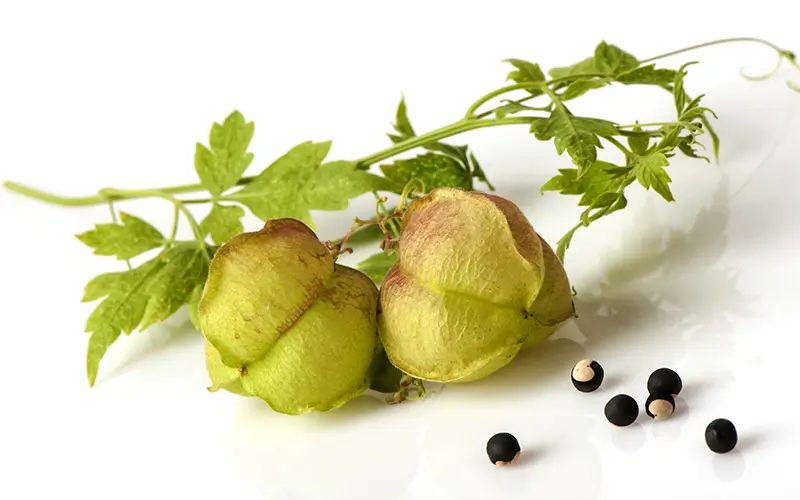Cardiospermum halicacabum L. belongs to the Sapindaceae family and is a dioecious climber with dissected leaves and small white flowers with balloon-like or heart-shaped fruits. Because of its fruit shape, it has gained the common name “balloon vine” or “heart seed vine.” A black seed with a heart-shaped aril (white in color) fascinates taxonomists. Found throughout India and in most other tropical and sub-tropical countries. As the plant contains HCN-splitting cyanolipids, it is strongly cyanogenic and toxic to livestock. Hunting poison was prepared from the leaf juice. The whole plant contains saponins, alkaloids, proanthocyanidins, apigenins, and stigmasterol.
Important formulations that contain Cardiospermum halicacabum’s root are:
No. | Formulation name | Used for Treatment of |
1 | Aragvadhadi Kwath Churna | Poisoning, vomiting, cough, itch, septic wounds, and leprosy |
2 | Kakadani root, pounded with sour gruel | Snake bites, internally and topically |
3 | Ghee processed with Kakadani and Kakamachi (Solanum nigrum) | Rat poisoning |
Miraculous leaves in various diseases
Leaves have astounding medicinal importance. Leaves cooked in castor oil are applied to many types of tumors, swellings, and rheumatism; leaves fried in groundnut oil are consumed to treat waist pain.
Ascites are treated with a decoction of leafy branches. Diarrhea and dysentery are treated with an enema containing a leaf infusion. On syphilitic sores, a paste of leaves is applied, and a necklace made from stems cures sores. To treat bladder infections, poultices of leaves mixed with other leaves are given. To get relief from headaches, the acrid smoke of dry powdered hot leaves or crushed, lightly boiled leaves is inhaled. Fresh juice from leaves cures earache.
For abnormal suppression of the menstrual cycle, leaves are used. Leaves are potent in treating insanity, convulsion, catarrh, fever, indigestion, urinary complaints, venereal diseases, skin diseases, itchy skin, swellings, and filariasis. In fever, leaves are grounded with the stem bark of Carissa spinarum L. (Karonda). In ephemeral fever, the leaves of Andrographis paniculata (Burm.f.) Nees (Kalmegh), along with those of Vitex negundo L (Nirgundi), Cardiospermum halicacabum, the tubers of Curculigo orchioides Gaertn. (Kali Musli), and Drimia indica (Roxb.) Jessop (Indian Squill), is pounded, and an extract is prepared. Fresh leaf juice is given to asthma patients, and it also reduces obesity.

The noteworthiness of roots in different ailments
The roots possess medicinal properties and are known for their emetic, emmenagogue, refrigerant, stomachic, and sudorific effects. A decoction made from roots and leaves is given in the treatment of rheumatism, piles, nervous diseases, chronic bronchitis, hemorrhoids, and Phthisis. Decoction of the root is considered diuretic, diaphoretic, and laxative.
It is used in the treatment of amenorrhoea (missing one or more menstrual periods) and bleeding piles. The plant’s juice is applied to the ear to alleviate earache and discharge from the meatus. It is also used in the treatment of suppurative otitis, sometimes also for nosebleeds. Roots are used for fever, anaemia, jaundice, colic, hydrocele, loss of memory, osteoarthritis, leprosy, snake bite, rat bite, bronchitis with fever, alopecia, severe abdominal distress, calculus, ghost syndrome, and fear psychosis.
Root powder is given to treat rat and snake poisoning, cough with fever, scrotal enlargement and jaundice, diarrhea, and dysentery; root paste is applied over the joints to get relief from rheumatism; the bark of Holarrhena antidysentrica and the roots of Cardiospermum halicacabum and Solanum torvum are crushed; and the paste is taken for gastroenteritis.
Valuable emenagogue activity with curing properties in amenorrhoea
For emenagogue activity, equal parts of the leaves of Cardiospermum halicacabum, potassium carbonate, the root of Acorus calamus, and the root bark of Terminalia elliptica Willd. are applied to a paste with milk. In amenorrhoea, the same mixture is given for 3 days; it gives a free menstrual flow in about 3 days. Fried leaves are applied to the pubes to increase the menstrual flow in amenorrhoea. It is also an amazing insect repellent.
Abridgement of its medicinal properties
The whole plant is regarded as a CNS depressant, anti-inflammatory, purifier, antifilarial, antiparasitic, antibacterial, analgesic, stomachic, diuretic, antidiarrheal, laxative, antidote, emetic, emmenagogue, cooling, rubefacient, diaphoretic, sudorific, and antihyperglycemic. It is also used to treat earache, fever, nervous disease, eczema, edema, urinary tract infections, rheumatism, rheumatoid arthritis, swellings, sprains, and external wounds. A whole plant crushed in groundnut oil is applied all over the body in cases of fever and jaundice. Pills from the whole plant paste are used to treat asthma. Plant juice is fed to infants with flatulence, and colic, whole plant fried with sulfur and human hairs, made into a paste with mustard oil, and applied for eczema. In short, the whole plant has also been used both internally and externally for rheumatism and lumbago.
It is recommended that some traditional uses and literature support these medicinal claims and should confirm the safety and efficacy of Cardiospermum halicacabum for these applications. If you are considering using balloon vine for medicinal purposes, you should check with a healthcare practitioner to establish its safety and suitability for your unique health condition. Furthermore, the dosage and preparation procedures may differ, so seek expert assistance.
Authors: Shakti Jha and Dr. Sanjoy Gupta
Reference :
- Aslam, J., Verma, C., & Hussain, C. M. (2023). Electrochemical and analytical techniques for sustainable corrosion monitoring: Advances, challenges, and opportunities. Elsevier.
- Khare, C. P. (2007). Indian medicinal plants. Springer-Verlag Berlin Heidelberg.
- Neuwinger, H. D. (1996). African ethnobotany: Poisons and drugs: Chemistry, pharmacology, toxicology. Chapman & Hall.
- Quattrocchi, U. (2012). CRC World Dictionary of Medicinal and poisonous plants common names, scientific names, eponyms, synonyms, and etymology. CRC.
- Singh, M. P., & Panda, H. (2005). Medicinal herbs with their formulations. Daya Publishing.

